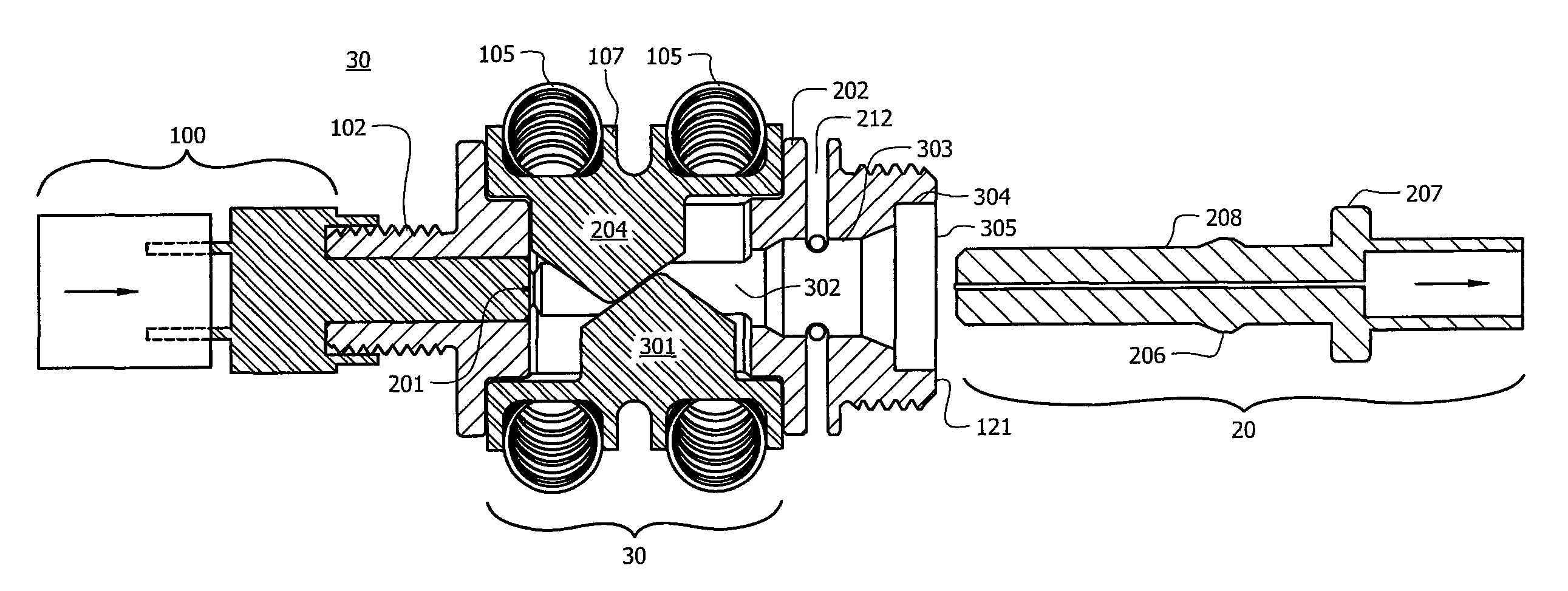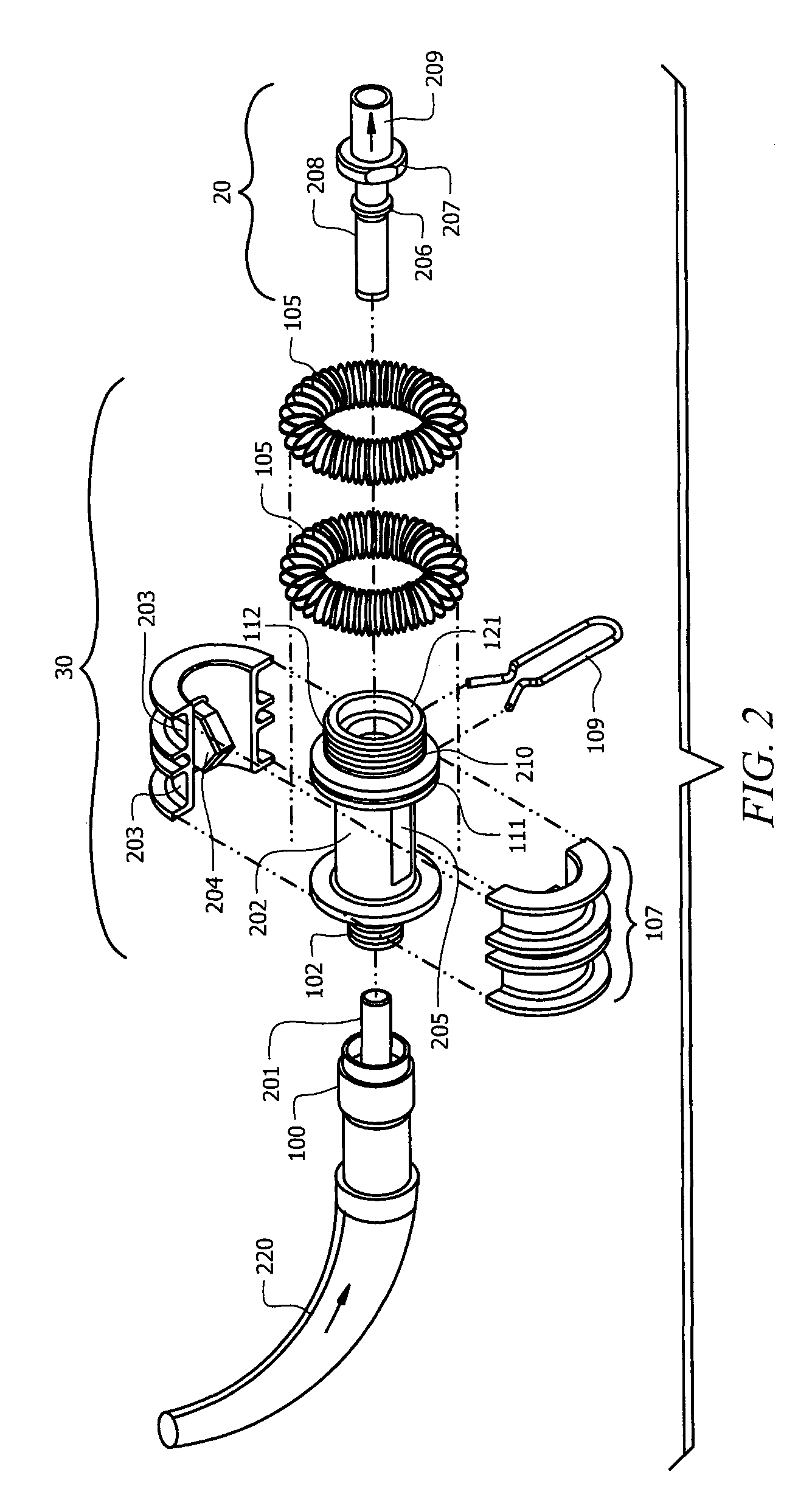Optical transmission coupling
a transmission coupling and optical technology, applied in the field of optical transmission coupling, can solve the problems of emitted diodes, lasers, lasers, etc., injuring people, and damage to the light will endanger those exposed
- Summary
- Abstract
- Description
- Claims
- Application Information
AI Technical Summary
Benefits of technology
Problems solved by technology
Method used
Image
Examples
embodiment 700
[0039]FIG. 7 is perspective view of an embodiment 700 of the present invention that utilizes torsion spring gated pins 702-1 and 702-2 that rotate out of the light path to prevent damaging light from being transmitted outside of the coupling body. In one version of this embodiment as seen in FIG. 7A, spring-wound gated pins 701 are inserted into staggered holes through the body of the coupling. The pins are linearly positioned along coupling body 700, and wound with a tension spring (not shown) that acts to allow the rotation of spring-wound pin 701 to a position in which gate tabs 720-1 and 720-2 extend into light canal 730 when the ferrule is not inserted. When the ferrule is inserted into the coupling, the ferrule pushes gate tabs 720-1 and 720-2 outward toward the sides of coupling body 700 causing the spring-wound pins to rotate against force exerted by the torsion springs 703. When the ferrule is removed, the torsion spring forces the pins to return to their natural position i...
embodiment 800
[0040]FIG. 8 shows embodiment 800 of the present invention that utilizes linear springs 802 to rotate gate 805 into light path 806 to prevent damaging light from being transmitted outside of the coupling body when an output optic device is not connected. Gate 805 rotates with pin 804 (which in turn rotates within slots (not shown) in housing 801. Gate 805 is shown in the open position, as though a downstream connector (not shown) were connected to coupling 800. Any configuration of rotation is possible and a plurality of such gates would advantageously be used in a coupling. When an output optic device is inserted into coupling 800, its ferrule pushes against gates 804 to cause the gate to rotate outward toward the sides of coupling body 800 causing the spring-based gates to rotate. When the ferrule is removed, the springs force the gates to return to their resting (closed) positions in which the gates block the light canal of coupling body 800, thereby preventing damaging light fro...
embodiment 90
[0041]FIGS. 9 and 9A show views of an embodiment 90 that utilizes elastomeric housing 901 for supplying the force for controlling the flexing of gates that prevent damaging light from being transmitted outside of the coupling body. Window 902 is used to allow the housing to be molded and to form gates within the housing body for selectively blocking light from being transmitted through the light canal of the coupling at the wrong time.
[0042]FIG. 9A shows light canal 91 having gates 903 positioned therein. Gates 903 are elastomeric and, if desired, can be formed as part of housing 901 as above-discussed. Gates 903 function in the same manner as do the gates in the other embodiments in that when a downstream optical connector is inserted in the distal end of the coupling the ferrule on the inserted optical device pushes open the optic canal by causing the gates to flex outward. Note that the ends of the gates do not necessarily have to touch the sides of the optic canal since the dama...
PUM
 Login to View More
Login to View More Abstract
Description
Claims
Application Information
 Login to View More
Login to View More - R&D
- Intellectual Property
- Life Sciences
- Materials
- Tech Scout
- Unparalleled Data Quality
- Higher Quality Content
- 60% Fewer Hallucinations
Browse by: Latest US Patents, China's latest patents, Technical Efficacy Thesaurus, Application Domain, Technology Topic, Popular Technical Reports.
© 2025 PatSnap. All rights reserved.Legal|Privacy policy|Modern Slavery Act Transparency Statement|Sitemap|About US| Contact US: help@patsnap.com



